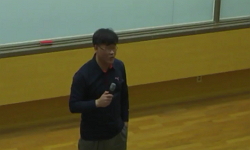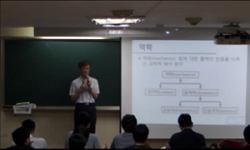The purpose of this study was to perform a kinematic analysis of the high jump techniques of the three men`s medalists at the 2011 IAAF Championships in Daegu (August 27-September 4, 2011), In particular, a three-dimensional coordinates method was use...
http://chineseinput.net/에서 pinyin(병음)방식으로 중국어를 변환할 수 있습니다.
변환된 중국어를 복사하여 사용하시면 됩니다.
- 中文 을 입력하시려면 zhongwen을 입력하시고 space를누르시면됩니다.
- 北京 을 입력하시려면 beijing을 입력하시고 space를 누르시면 됩니다.

2011 대구세계육상선수권대회 남자 높이뛰기 메달리스트들의 바이오메카닉스적 특성 분석 = Biomechanical Analysis of Men`s High Jump Medalists in IAAF World Championships, Daegu 2011
한글로보기https://www.riss.kr/link?id=A60047854
- 저자
- 발행기관
- 학술지명
- 권호사항
-
발행연도
2011
-
작성언어
Korean
- 주제어
-
KDC
692.1
-
등재정보
KCI등재
-
자료형태
학술저널
- 발행기관 URL
-
수록면
573-584(12쪽)
-
KCI 피인용횟수
2
- 제공처
-
0
상세조회 -
0
다운로드
부가정보
다국어 초록 (Multilingual Abstract)
The purpose of this study was to perform a kinematic analysis of the high jump techniques of the three men`s medalists at the 2011 IAAF Championships in Daegu (August 27-September 4, 2011), In particular, a three-dimensional coordinates method was used to analyze the last three strides before touchdown, the touchdown techniques, and the movements after takeoff toward the bar. An analysis of the, data for the biomechanical characteristics of the world`s best high jumpers could contribute to an improvement in the performance of a national high jumper. The first conclusion of the data analysis was that the arm movements of the gold medalist, J. Williams, had a single arm form, whereas the arm movements of the other medalists were a double arm form. Second, the difference in the knee joint angles upon touchdown and toe-off was 10˚. Third, J. Williams achieved his maximum CM height after takeoff (1.26m) using the maximum flexion of his knee joint. Fourth, the foot contact duration of A. Dmitrik (0.11 s) was the shortest among the medalists, and the ratio for his transformation of horizontal velocity to vertical velocity was the greatest (75.25%) among the three. Last, the maximum CM height of T. Barry was the greatest, and his foot contact duration was the longest.
참고문헌 (Reference)
1 이진택, "제16회 아시아선수권대회 남자 높이뛰기 발구름 동작의 운동학적 분석" 국민체육진흥공단 체육과학연구원 17 (17): 134-143, 2006
2 성낙준, "높이뛰기의 바 넘기 동작을 위한 각운동량 분석" 한국운동역학회 14 (14): 119-134, 2004
3 Greig, m.p., "The influence of touchdown parameters on the performance of a hugh jumper" 16 : 367-378, 2000
4 Ae Michiyoshi, "The Use and the Contribution of Body Segments for Take-off of High Jump and Long Jump" 9 (9): 130-136, 1990
5 Sung, R. J., "Take-off Motions in Fosbury flop" Seoul National Graduate University 1991
6 이진택, "Stefan Holm의 높이뛰기 발구름 동작에서의 충격력과 상지와 하지 분절의 운동학적 분석" 한국운동역학회 21 (21): 97-105, 2011
7 Ae Micjiyoshi, "Sports Performance measured by Biomechanical Method" 11 (11): 725-729, 1992
8 Conrad, A., "Scientific research project at the games of the XXIth olympiad : Biomechanical analysis of the high jump" 1 : 177-217, 1990
9 Mizumura Shinji., "Relationship between the Take-off Movement and the Ankle Injury on High Jump (Fosbury Flop), In Reaserch of Jump"
10 Bothmischel, V. E., "Model characteristics of the high jump run-up" 28 (28): 3-6, 1990
1 이진택, "제16회 아시아선수권대회 남자 높이뛰기 발구름 동작의 운동학적 분석" 국민체육진흥공단 체육과학연구원 17 (17): 134-143, 2006
2 성낙준, "높이뛰기의 바 넘기 동작을 위한 각운동량 분석" 한국운동역학회 14 (14): 119-134, 2004
3 Greig, m.p., "The influence of touchdown parameters on the performance of a hugh jumper" 16 : 367-378, 2000
4 Ae Michiyoshi, "The Use and the Contribution of Body Segments for Take-off of High Jump and Long Jump" 9 (9): 130-136, 1990
5 Sung, R. J., "Take-off Motions in Fosbury flop" Seoul National Graduate University 1991
6 이진택, "Stefan Holm의 높이뛰기 발구름 동작에서의 충격력과 상지와 하지 분절의 운동학적 분석" 한국운동역학회 21 (21): 97-105, 2011
7 Ae Micjiyoshi, "Sports Performance measured by Biomechanical Method" 11 (11): 725-729, 1992
8 Conrad, A., "Scientific research project at the games of the XXIth olympiad : Biomechanical analysis of the high jump" 1 : 177-217, 1990
9 Mizumura Shinji., "Relationship between the Take-off Movement and the Ankle Injury on High Jump (Fosbury Flop), In Reaserch of Jump"
10 Bothmischel, V. E., "Model characteristics of the high jump run-up" 28 (28): 3-6, 1990
11 Dapena, J., "Mechanics of translation in the fosbury flop" 12 (12): 7-44, 1980
12 Muraki, Y., "Fundamentals of approach running & takeoff" 89 : 2843-2845, 1984
13 Ae Michiyoshi, "Body Segment Parameter of Japanese Boys and Athletes" 15 (15): 155-162, 1996
14 Kaneko masahiro, "Biomechanics (Scientific Basics of Physical Exercise)" Tokyo :Kyorin-Shoin 2006
15 Kaneko M., "Biomechanics (Scientific Basics of Physical Exercise)" Tokyo : Kyorin-Shoin 2006
16 Dapena, J., "Biomechanical of High jump #5(men)" Report for scientific services project(USOC/TAC). 1986
17 Dapena, J., "Biomechanical Analysis of the Fosbury Flop(partⅠ)" 104 : 3307-3317, 1988
18 Ae Michiyoshi, "Biomechanical Analysis of Women's High Jump Winners in IAAF World Championships in Athletics Osaka 2007. In The Performence and Techniques of the World's Top Athletes"
19 Iiboshi Akira., "Biomechanical Analysis of High Jumpers.In The Techniques of the World's Top Athletes.(Ed.).Nippon Rikujiyo Kyogirenmei" Nippon Rikujiyo Kyogirenmei 169-184, 1994
20 Iiboshi A., "Biomechanical Analysis of High Athletes" Nippon Rikujiyo Kyogirenmei 169-184, 1994
21 Ae Michiyoshi, "Biome chanical Analysis of Men's High Jump Winners in IAA F World Championships in Athletics Osaka (2007). In The Performence and Techniques of the World's Top A thletes"
22 Dapena, J.(, "Basic and applied research in the biomechanics of high juming" 25 : 19-33, 1987
23 Reid, p., "Approach and take-off for the back lay-out high jump" 8 (8): 5-9, 1986
24 Do, H. Y., "A kinematic Analysis of the last 3 strides of the Run-up and Take-off Motion in the Men's High Jump" 41 (41): 837-850, 2002
동일학술지(권/호) 다른 논문
-
2011 대구 세계육상선수권 대회에 참가한 한국 여자 창던지기 선수와 입상자들의 3차원 운동학적 비교 분석
- 한국운동역학회
- 김동수 ( Dong Soo Kim )
- 2011
- KCI등재
-
2011 대구세계육상선수권대회 운동역학 프로젝트 수행 경과보고
- 한국운동역학회
- 배영상 ( Young Sang Bae )
- 2011
- KCI등재
-
2011 대구세계육상선수권대회 100m 남자 결승전 중간질주구간의 운동학적 분석
- 한국운동역학회
- 류지선 ( Ji Seon Ryu )
- 2011
- KCI등재
-
2011 대구세계육상선수권대회 100 m 여자 결승전의 운동학적 분석
- 한국운동역학회
- 류지선 ( Ji Seon Ryu )
- 2011
- KCI등재
분석정보
인용정보 인용지수 설명보기
학술지 이력
| 연월일 | 이력구분 | 이력상세 | 등재구분 |
|---|---|---|---|
| 2022 | 평가예정 | 계속평가 신청대상 (계속평가) | |
| 2021-12-01 | 평가 | 등재후보로 하락 (재인증) |  |
| 2018-01-01 | 평가 | 등재학술지 유지 (등재유지) |  |
| 2015-01-01 | 평가 | 등재학술지 유지 (등재유지) |  |
| 2011-01-01 | 평가 | 등재학술지 유지 (등재유지) |  |
| 2009-01-01 | 평가 | 등재학술지 유지 (등재유지) |  |
| 2007-01-01 | 평가 | 등재학술지 유지 (등재유지) |  |
| 2004-01-01 | 평가 | 등재학술지 선정 (등재후보2차) |  |
| 2002-01-01 | 평가 | 등재후보학술지 선정 (신규평가) |  |
학술지 인용정보
| 기준연도 | WOS-KCI 통합IF(2년) | KCIF(2년) | KCIF(3년) |
|---|---|---|---|
| 2016 | 0.76 | 0.76 | 0.75 |
| KCIF(4년) | KCIF(5년) | 중심성지수(3년) | 즉시성지수 |
| 0.79 | 0.68 | 0.864 | 0.14 |




 ScienceON
ScienceON KISS
KISS



